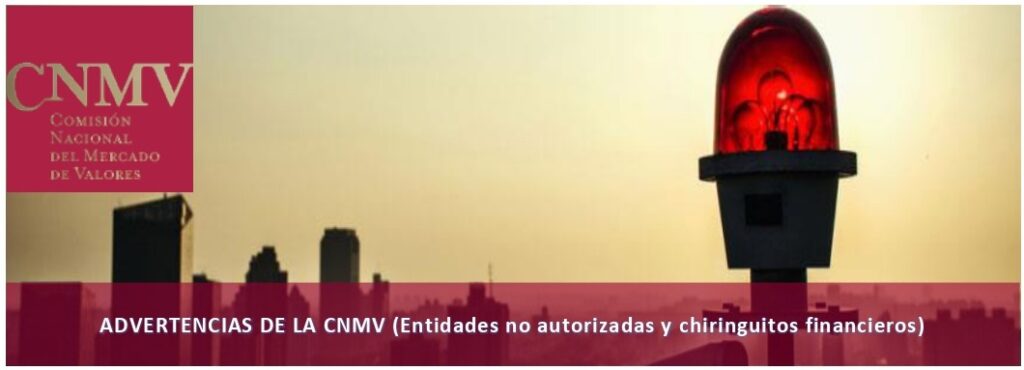More than 400,000 Spaniards have fallen for digital currency scams, 90% through advertisements posted on social networks.
ETF Corp, AllCrypt Capital and Trading Business Academy are some of the 309 warnings issued by the National Securities Market Commission (CNMV) about unregistered entities (financial beach bars) up to October this year (latest available data). In the last four years, the number of warnings about “financial beach bars” in Spain has multiplied by eight and practically all the companies included in this blacklist have a common link: they are dedicated to cryptocurrencies.



In the absence of regulation to protect investors, and even in the absence of supervision by monetary authorities such as the Bank of Spain, cryptocurrency platforms are proliferating on social networks. And it does not seem that cases such as FTX or the more recent Binance will stop this trend. They have already caused fraud losses to more than 400,000 Spaniards and 90% fell into the trap precisely through the networks, according to EurocoinPay, a platform registered with the Bank of Spain for buying and selling electronic currencies. It is worth noting that cryptocurrencies moved 60,000 million euros in Spain in 2021, a figure that corresponds to 4.8% of GDP, according to data provided by the Bank of Spain itself.
If in 2018 the CNMV alerts amounted to 63, in line with previous years, in the following years these warnings exceeded 300. From the regulator they point out that the financial beach bars now offer cryptocurrencies “because they are fashionable”. “Before, they sold commodities,” they say. Their secret has been to use social networks to reach more people. “The cost of advertising on social networks is much cheaper,” explains Darío García, an analyst at XTB. The CEO and co-founder of EurocoinPay, Herminio Fernández, states categorically that “social networks are a total fraud”. “Right now, on social networks, every 14 advertisements there is one fraudulent one”, he says.
And the fact is that 90-95% of scams do not come from official companies, but from people who impersonate other companies or individuals recognised on social networks. This is why their advertisements are so credible. Moreover, at the beginning, in 2018, they were mainly aimed at the younger and generally less informed segment. Today, the profile of the cryptocurrency investor is a male between 26 and 40 years of age, who uses social networks and the internet intensively, and chooses to invest less than 5% of his capital. “The danger nowadays lies” in this age group “because the scams are more sophisticated”, says Herminio Fernández.
Currently, both Facebook and Twitter maintain a very strict policy on cryptocurrency advertising, but if the platforms are able to legally bypass the restrictions due to the lack of regulation, neither social network can prevent ads for these assets. “Social networks are so guilty that they even have some moral responsibility”, says XTB’s Garcia, “but they are not to blame.” “The crypto world is not a fraud, but the companies that operate in the name of cryptocurrencies are the ones that are committing scams,” he adds.
Late and incomplete regulation
Beyond the frauds that materialise every day on social networks, cryptocurrency scams are shaking the foundations of some of the most important cryptocurrency exchange platforms. Up until now, the biggest failure has been that of FTX, a bankruptcy caused by massive customer fraud and money laundering perpetrated by its CEO, Sam Bankman-Fried, who has now been arrested. But the reality is that since the beginning of November all cryptocurrencies, such as bitcoin and ethereum, have been falling on the stock market, and an investigation by the US Department of Justice into Binance and its CEO, Changpeng Zhao, has come to light.
In the case of FTX, what began as a liquidity crisis in early November due to Binance’s refusal to bail out the platform, ended in a bankruptcy that left an $8 billion hole and $3 billion in debt. Its CEO, Sam Bankman-Fried, had been hailed as the ‘wonder boy’ of cryptocurrencies and FTX was once valued at $32 billion. And Binance had $60 billion in assets until today, according to Nansen data, when its investors withdrew $1.6 billion after the US investigation against it became known. In total, some 30 million people have relied on Binance to exchange digital currencies.
The forecast is that other digital currency platforms will fall in the coming months: “If there are audits due to the MiCA regulation, there will be a very important sifting of platforms because not all of them have real backing for the investments they make,” says Herminio Fernández. The president of the CNMV a few weeks ago, Rodrigo Buenaventura, said a few weeks ago about this sector that “the least socially useful part is all this kind of collective phenomenon around what will be the next cryptocurrency to make a splash“, because for him “it contributes nothing to Spanish society”.
In the wake of these latest scandals, European Central Bank (ECB) president Christine Lagarde has urged the European Union to “swiftly implement” the world’s only ongoing cryptoasset regulation, the Market Regulation for Cryptoassets (MiCA). “Its implementation will take a few months, if not a couple of years, unfortunately,” he said. It is a regulation that began to be discussed in September 2020, but whose approval by the three European institutions (the European Commission, the European Parliament and the European Council) has been delayed until just a few weeks ago, and also contemplates an adaptation period that will delay its entry into force in a practical way.
In any case, Lagarde has clarified that the MiCA “can only be a first step”, as there are some gaps around the protection of users. For example, it is still not very clear how ‘cold wallets’ will operate, i.e., when the investor or client has their own cryptocurrencies and protects them with public keys, something that all experts have called for. For Darío García, “regulation is long overdue and is aimed at the financial sphere, not the legal sphere“, because “for now only the fiscal sphere can be regulated”.

When the regulation is activated on 13 February 2023, “it will be particularly important that the services provided comply with the services determined by MiCA, so that the custody requirements are fully met, in which there must be a 1:1 backing of the cryptoassets deposited by customers”, explains Alfonso Ayuso, head of the Cryptocurrencies and Blockchain vertical of the Spanish Association of Fintech and Insurtech, the Spanish Association of Fintech and Insurtech. Even so, Herminio Fernández reminds us that “the world of crypto was not born to be regulated in an extreme way“. “The blockchain is a blessing for the world, but governments have to regulate it”.
Source: el Periódico de España/activos
Disclaimer: The information set out herein should not be taken as financial advice or investment recommendations. All investments and trading involve risk and it is the responsibility of each individual to do their due diligence before making any investment decision.
Repercussions of the article in other media:
https://www.laopiniondemurcia.es/economia/activos/2022/12/14/cnmv-multiplica-ocho-alertas-inversores-79940432.html
https://www.diariodemallorca.es/economia/activos/2022/12/14/cnmv-multiplica-ocho-alertas-inversores-79940421.html
https://www.laopiniondezamora.es/economia/activos/2022/12/14/cnmv-multiplica-ocho-alertas-inversores-79940422.html
https://www.elperiodicomediterraneo.com/economia/activos/2022/12/14/cnmv-multiplica-ocho-alertas-inversores-79940433.html
https://galego.farodevigo.es/economia/activos/2022/12/14/cnmv-multiplica-ocho-alertas-inversores-79940423.html
https://www.farodevigo.es/economia/activos/2022/12/14/cnmv-multiplica-ocho-alertas-inversores-79940423.html
https://www.sport.es/es/noticias/economia/cnmv-multiplica-ocho-alertas-inversores-79940436
https://www.levante-emv.com/economia/activos/2022/12/14/cnmv-multiplica-ocho-alertas-inversores-79940428.html
https://www.laopinioncoruna.es/economia/activos/2022/12/14/cnmv-multiplica-ocho-alertas-inversores-79940425.html
https://www.diariodeibiza.es/economia/activos/2022/12/14/cnmv-multiplica-ocho-alertas-inversores-79940431.html
https://www.lne.es/economia/activos/2022/12/14/cnmv-multiplica-ocho-alertas-inversores-79940427.html
https://www.diariocordoba.com/economia/activos/2022/12/14/cnmv-multiplica-ocho-alertas-inversores-79940430.html
https://www.informacion.es/economia/activos/2022/12/14/cnmv-multiplica-ocho-alertas-inversores-79940437.html
https://www.eldia.es/economia/activos/2022/12/14/cnmv-multiplica-ocho-alertas-inversores-79940420.html
https://www.elperiodicoextremadura.com/economia/activos/2022/12/14/cnmv-multiplica-ocho-alertas-inversores-79940434.html
https://www.laprovincia.es/economia/activos/2022/12/14/cnmv-multiplica-ocho-alertas-inversores-79940438.html
https://www.laopiniondemalaga.es/economia/activos/2022/12/14/cnmv-multiplica-ocho-alertas-inversores-79940429.html
https://www.elperiodicodearagon.com/economia/activos/2022/12/14/cnmv-multiplica-ocho-alertas-inversores-79940435.html
https://www.elperiodico.com/es/suplemento-activos/20221214/cnmv-multiplica-ocho-alertas-inversores-79940439




